Microgreens Farming, Cost and Profit Information
INTRODUCTION TO MICROGREENS FARMING:
Microgreens – this term refers to the foliage, baby vegetables, and legumes that are harvested at a seedling stage, just after the sprouting has begun. Generally, all edible leaves are categorized as Microgreens but chefs, in particular, consider Microgreens to have special flavors, color, and texture like the mustard and the radish greens. Sprouts and Microgreens are sometimes considered similar but they differ in the way of germinating. Sprouts germinate in water, whereas Microgreens are grown in soil and are harvested. These tender leaves contain 40 times more nutrition and high vitamin C, E, and K content when compared to the fully-grown leaves. It is also believed that Microgreens don’t always require soil to grow, but they need good controlled conditions of light, air, and water. The height of Microgreens is about one to two inches when harvested. Microgreens are currently used in many cuisines for garnishing and salad dressings. Microgreens farming is a low investment high dividend agricultural practice as it requires less space and money but yields serious returns. The common considerations of Microgreens farming are beets, arugula, mustard, radish, endive, kale, etc.
NEED FOR MICROGREENS FARMING:
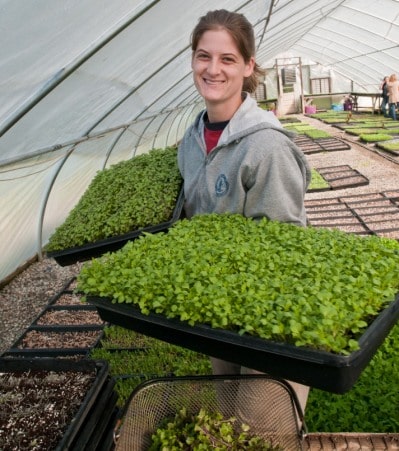
While considering urban commercial farming, Microgreens farming can be appealing for certain reasons:
- When a person has less experience in farming practices but is keen on urban farming then Microgreens farming is just the right idea because plants are not grown until maturity, they are grown for just two weeks and harvested which reduces the risk and cost of investment.
- Less space occupancy makes Microgreens farming a better option when compared to traditional crop farming.
- Microgreens have a high value in the market when compared to normal vegetables and are demanded by high-end restaurants.
- If the demand for Microgreens can be sourced from the local market, then it is advantageous for restaurants because shipping these Microgreens is very difficult.
FARMING PROCESS FOR MICROGREENS:
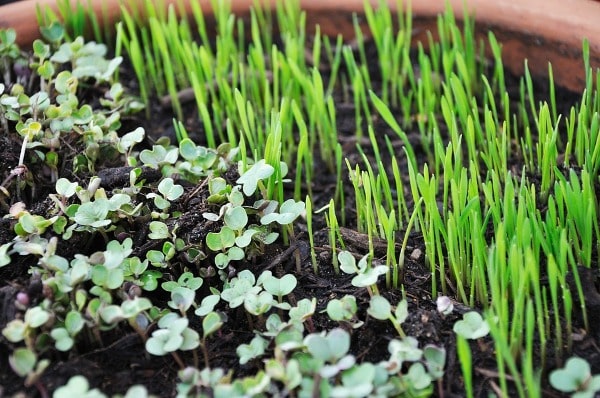
Research has shown that Microgreens farming needs good observation and maintenance of external conditions for achieving good results. Details like light, soil, water; harvesting should be finely tuned to have optimized output.
- Soil beds are prepared by filling organic soil rich in nitrogenous content in the trays. The soil is pressed using cardboard and compacted.
- The seeds to be grown are sprinkled on the top of the soil. Some seeds are soaked in the water so that they absorb the required water content.
- Paper towels or plastic covers are laid on top of the seeds. This cover keeps the environment warm for the seeds to germinate.
- Water the seeds as required and place them in the nursery. Enough light is provided inside the nursery. The flaps of cardboards cover the sides of the bunk beds where the Microgreens are placed. Flaps on the inside are made of aluminium foil to reflect light onto the seeds. 12 to 16 hours of sunlight is given to the seeds for proper and fast germination.
- The harvesting is done when the seedling grows to a height of 2 inches. A sharp knife is used to slice the base of the Microgreens. They should be harvested with care otherwise they wilt very quickly.
- The leftover things in the tray after the harvest are collected in a vermiculture bin to be used later.
MATERIALS REQUIRED FOR MICROGREENS FARMING:
- Tray or a container
- Organic seeds
- Spray bottles
- Organic soil or raising a medium rich in nitrogen
- Paper towel or a chux cloth to cover the tray
- Plant labels and markers to label the date and variety
EQUIPMENT REQUIRED FOR A LARGE SCALE MICROGREENS FARMING:
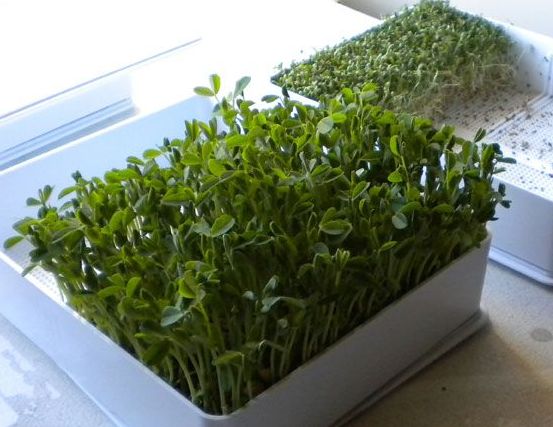
Some extra considerations have to be made when farming for Microgreens on a larger scale. When there is no possibility of Microgreens farming in an indoor area, then a greenhouse or a hoop house is a possibility for year-round production. A hoop house can be constructed with low-cost or recycled materials.
Heating system: Solar heating is a good option for hoop houses during the spring, but during winter alternate sources of heating should be provided for efficient plant growth. The growing area can be heated using heat mats and biogas systems with the help of water heaters.
Growing area: an elevated table-like bed structure is used by a farmer for Microgreens farming because it is easier for seeding and harvesting than groundwork. A table which is accessible from all sides is chosen for this purpose and the width of the bed should be easily available from each side of the table.
Heat mats: electric heat mat is used during the winter to heat the beds in the growing area without dissipating the entire heat to the hoop house. A much cheaper and efficient source of heating is through growing mats with the hot fluid circulating system. Glycol fluid is used as a heating fluid in these systems which circulate through the mats.
Water supply: constant water supply is needed to maintain the moisture level of the soil in the growing area. Long hose pipes with spray nozzle necks are best suited for the purpose of Microgreens farming
Ventilation: large fans have to be established to provide ventilation to the Microgreens so as to prevent fungus in the winter and cooling in summer. The fans keep the hoop house at optimum temperature and moisture levels with adjustments made as and when required by the farmer. Fans also keep the air circulation intact in the area of Microgreens farming. Large barn fans or household table fans can be used for this purpose.
Area for processing: Microgreens are washed in a clean sink and dried on a large table space.
Packaging: micro-perforated food bags with a heat sealer is recommended to pack the Microgreens such that they are prevented from tampering and can also breathe within to stay fresh and last longer.
Refrigeration: before the Microgreens are delivered to the required location they have to be packed and refrigerated properly otherwise they would wilt. A normal household refrigerator is good enough for storing Microgreens.
BENEFITS and ADVANTAGES OF MICROGREENS FARMING:
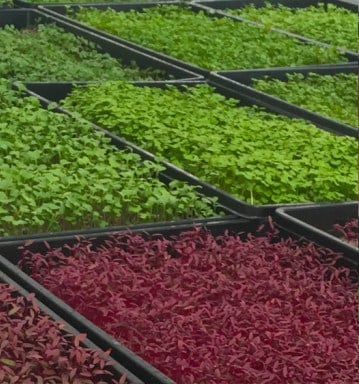
- Microgreens are quick to grow because they hardly take two or three weeks time to grow and be harvested.
- Many plant types can be grown together in a small area. Therefore Microgreens farming is considered to have a high yield to space ratio.
- Healthy, organic green food can be grown in minimum time with less time and effort.
- For people living in an urban area where farming or gardening is difficult due to space constraints, Microgreens farming is a perfect solution.
- The basic requirements for Microgreens farming are simple: water, good light, tray, and tables for setting up plants and a growing medium.
- Green leaves for salads, soups, garnishing, and sandwiches are all-season crops and can be grown as Microgreens in any climatic condition.
- Microgreens can be grown as a kitchen garden in an extremely small balcony or shade house without the need for any extra space or equipment.
- Microgreens are nutrient-rich food with a variety of digestible vitamins, minerals, and phytonutrients. They contain living enzymes and nutrients along with good flavour, colour, and texture.
- Microgreens are not cooked generally they are used before serving. Using Microgreens in this way maximizes the nutrient intake content because there is no loss of nutrients.
- The texture of Microgreens is delicate and crunchy which is why they are used as garnishing agents.
- Once the seeds are sown many types of Microgreens grow again and can be harvested several times.
SEEDS MOSTLY GROWN IN MICROGREENS FARMING:
There is a long list of Microgreens that can be grown, but some commonly grown varieties are basil, beets, broccoli, cabbage, celery, chard, cilantro, spinach, parsley, lettuce, chervil, kale, radish, peas, arugula, mustard, kohlrabi, amaranth, and sorrel. It is worth mentioning here that not all seeds are safe to be grown as Microgreens because to protect the seeds during storage they are treated with chemical fungicides and pesticides. Commercial purpose seeds do contain harmful chemical content. Therefore, it is advisable to use untreated seeds or seeds with organic treatment.
Read Bonsai Tree Growing.
GROWING MICROGREENS AT HOME:
There are four simple steps to be followed to grow Microgreens at home in the kitchen garden.
- The seeds being used are pre-soaked in warm water overnight so that they germinate quickly.
- A paper towel is laid in the tray at the bottom and three-fourth of the tray is filled with a moist growing medium with a depth of 3 cm. Seed-raising mix can be added to the tray for an extra boost during germination.
- The seeds are generously spread over the mix and pressed lightly. Sieved compost or vermiculture of about 0.5cm thickness can be spread over the seeds. The seeds are lightly watered using a spray bottle. Place the tray in a warm spot with a drainage tray. The soil moisture content is checked every day and then water is sprayed accordingly. The soil should neither be dry nor flooded with water. A punnet lid is placed on the tray so that warmth is provided to the seeds. Instead of this plastic bag with holes can be covered on the tray to allow airflow.
- As the germination starts, the plants can be supplied with seaweed solutions to improve the nutrition content and flavor. When the Microgreens have attained 3 inches height, then scissors is used to harvest them such that they are cut just above the soil level.
ECONOMICS/COST AND PROFIT OF MICROGREENS FARMING:
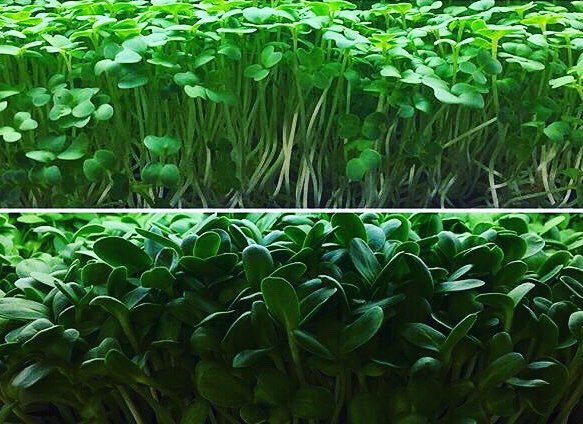
There are two types of investments included one is the fixed costs and the second is the variable costs. The fixed costs are for the propagation trays of size 10 x 20” which cost around $1 / tray. The variable costs include seeds, soil, water, packaging, etc. The seeds for Microgreens farming are estimated to cost around $15/ lb. It is observed that 1 tray can handle 1 ounce of seeds so the cost of seeds per tray is $1. 75/25 mix of potting soil and coconut coir per tray cost around $1 depending on the way the tray is filled. The price of packaging material depends on how is it required by the customers. They can be packed in disposable packets or reusable containers. The cost of Microgreens harvested per tray is around $2-4, which depends on many factors. Most Microgreens yield 8-12 ounces per tray, but for specific shoots like sunflower radish and peas, the yield is 12-18 ounces per tray. Apart from this, there are some hidden costs like labor when Microgreens farming is done on a bigger scale.
The total revenue generated is estimated at:
Production: 8-12 ounces/tray.
Pricing: $3 per ounce.
Revenue: $24-48.
Restaurants are the best customers for Microgreens farmers because they buy Microgreens in bulk on a regular schedule. The production can be streamlined when the requirement is known and orders come in on a weekly basis. Marketing Microgreens production is the most essential part of the farming process as this improves the production rate and demand.
The biggest motivation to grow our own greens is that the nutritional value of production has reduced over the past decades. Growing baby vegetables and leaves without many chemicals retain their nutrition levels. On the other hand sprouts have some bacteria grown on them due to the water content, but the Microgreens have negligible bacteria risk because they are grown in soil and only the leaf and plant are consumed instead of the root and seed. Microgreens farming is a type of decentralized farming, where the food is grown near the people who eat it. When produce is transported over long distances then it gets wasted and it amounts to 30-50% of the total food materials. Research has proven that the more we decentralize our food production and bring it close to our kitchen, we rely less on other sources of food and transport which ultimately improves our well-being.
In case if you are interested in this: How To Grow Organic Lettuce.
- Economical Aquaculture: A Guide to Low-Budget Fish Farming
- 15 Common Planting Errors That Can Doom Your Fruit Trees
- How to Make Houseplants Bushy: Effective Tips and Ideas
- Innovative Strategies for Boosting Coconut Pollination and Yield
- Pollination Strategies for Maximum Pumpkin Yield
- The Complete Guide to Chicken Fattening: Strategies for Maximum Growth
- Natural Solutions for Tulip Problems: 100% Effective Remedies for Leaf and Bulb-Related Issues
- Revolutionizing Citrus Preservation: Towards a Healthier, Greener Future
- Natural Solutions for Peony Leaf and Flower Problems: 100% Effective Remedies
- Maximizing Profits with Avocado Contract Farming in India: A Comprehensive Guide
- Natural Solutions for Hydrangea Problems: 100% Effective Remedies for Leaf and Flowers
- The Ultimate Guide to Choosing the Perfect Foliage Friend: Bringing Life Indoors
- From Sunlight to Sustainability: 15 Ways to Use Solar Technology in Agriculture
- The Ultimate Guide to Dong Tao Chicken: Exploring from History to Raising
- The Eco-Friendly Makeover: How to Convert Your Unused Swimming Pool into a Fish Pond
- Mastering the Art of Delaware Chicken Farming: Essentials for Healthy Backyard Flocks
- 20 Best Homemade Fertilizers for Money Plant: DIY Recipes and Application Methods
- How to Craft a Comprehensive Free-Range Chicken Farming Business Plan
- Brighten Your Flock: Raising Easter Egger Chickens for Beauty and Bounty
- How to Optimize Your Poultry Egg Farm Business Plan with These Strategies
- Subsidy for Spirulina Cultivation: How Indian Government Schemes Encouraging Spirulina Farmers
- Ultimate Guide to Raising Dominique Chickens: Breeding, Feeding, Egg-Production, and Care
- Mastering the Art of Raising Jersey Giant Chickens: Care, Feeding, and More
- Ultimate Guide to Raising Legbar Chickens: Breeding, Farming Practices, Diet, Egg-Production
- How to Raise Welsummer Chickens: A Comprehensive Guide for Beginners
- How to Protect Indoor Plants in Winter: A Comprehensive Guide
- Ultimate Guide to Grow Bag Gardening: Tips, Tricks, and Planting Ideas for Urban Gardeners
I want to learn Microgreens farming for commercial level…I want to take coaching ..Please suggest where it is possible…
And I want to learn organic farming.
We will update soon with a article of training institutes for all kinds of modern farming methods.
available markets in India…
I wanna learn microgreens farming for commercial level , if it is in bengaluru then it will be more convinient ,please suggest
Hi,Iam growing microgreens in Bangalore.Can you suggest how to market it properly.
Hey Vijay, where in Bangalore are you growing your Microgreens. I’m willing to market your product.
I am a farmar in bangalore south am willig to grow micrcogreens so suggest me
I have a lot of connections with Chef’s and other restaurants who are willing to purchase microgreens.
Hi Bhavadeep, pls share your contact for microgreens in Bangalore.
Hi
Im interested in growing microgreens on a commercial basis. Im based out of Chennai and would like to know if there is anyone who training/coaching that would be given
We have a medium sized land near kolkata.. We want to to agricultural activities there for some earnings.. We have no farming background or knowledge.. Can u suggest what may we grow? I also would like to mention that we r interested in microorganic farming…
We will be thankful to u if u kindly advise.
I want to learn growing microgreens but before that plz tell me what is the scope of this product . Since ppl are not much aware of it do it has a good market . I stay in northeast india.what is the prospect and what are the loopholes of this business.
What are the certificates of licenses required to grow and sell microgreens in bangalore.
Dear I am from Hyderabad, Telangana.i was planning to start microgreen and organic farming, i am wondering that is there any institute in hyderabad to get training and start the task.
Immense appreciate your response.
Thank You.
i am from Gurgaon, Haryana. I am growing Microgreens and want to start selling for commercial purpose. Please sugest where can I take help from in gorgaon.
I am producing microgreens. However marketing In Hyderabad is the issue. Any leads please..
I want to start a microgreen business in Bangalore. I would like to leant more and get to know more about the resources.
Where can I get good quality materials like Organic Trays, Seeds, and Coir Pith?
For Microgreens farming, also can some advise on suitable AC system with Humidity control and water treating unit
Ok so I live in west Texas, we have very heavy water, full of calcite because of the caliche in this area, we normally don’t drink the water.
My question is how would that effect the plants if at all?
I want to know more about Microgreens business